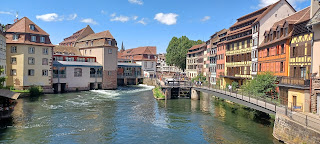After four months of not traveling post the Big Trip, we finally set off on July 1 for a trip that would take us technically to four countries: Switzerland and Luxembourg (both very briefly), but primarily the Alsace region of France and the Black Forrest, Rhine and Mosel Valleys in western Germany. We travelled for the first half of the trip with our friends Corrine and David, whom we hadn't seen in some 10 years (!), and we spent a great deal of time driving, as these areas are much easier to get around by car than by train.
The Alsace region is bordered by the Vosges Mountains to the west, and the Rhine River to the east. The historical problem is that the Germans believe the border between the two countries should be the mountains, while the French think it should be the river. Hence, this region has passed back and forth between the two multiple times over the centuries including four times between 1870 and 1945 (from France to Germany in the War of 1870, back to France in WWI, back to Germany in 1940 and finally (for now) back to France in 1945). As a result, the area has a bunch of adorable villages with an interesting mix of French and German cuisine.
Given the history of the region, it was appropriate that our first stop (after picking up Corrine and David in Basel and lunch in Guebwiller, a small Alsatian town) was the Hartmannswillerkopf -- Vieil Armand Memorial, an area where significant WWI battles took place.
Up the hill in front of Corrine and me is a hike in an area where many of the trenches from WWI have been preserved with lots of detailed information about the battles there. It was extremely interesting, but also sobering to see exactly how small and cramped the conditions for the soldiers were (the movies do not really do it justice).
As you can see, the area around the trenches has been allowed to return to nature and it is absolutely beautiful with stunning views. A little over a hundred years ago, this whole area was trenches, barbed wire and mud.
After our hike, we headed to our VRBO in the extremely small town of Beblenheim (population about 1,000). Our VRBO was very close to the town's adorable little church, which included one of the ever- present stork nests seen throughout the area.
The church became important the next morning when its bells not only started to chime the time at 6 am, they loudly played an entire tune for 4 minutes! We were somewhat amused, but more annoyed as we were on vacation and did not need the early wake-up call, which we decided was some kind of Calvinist work-ethic thing. This happens 7 days a week in most local towns apparently.
That first day, after coffee and pastries at the local bakery, we visited the nearby town of Colmar, home to the Unterlinden Museum, which houses the Isenheim Alterpiece (no photos were allowed in the museum, but it is worth checking out Wikipedia if you have any interest in Medieval art, and I mean who doesn't?).
In Colmar, we discovered that because people were generally not able to read in the middle ages, the buildings had elegant picture signs to show what they were:
Colmar also has an area they call little Venice where boats (but not gondolas) ply the canals:Lunch that day was several Alsatian specialties, and (of course) a crisp Alsatian white wine -- there are so many types to try.
We also visited the largest city in the Alsace region: Strasbourg (population around 300.000), home of the European Union Parliament and other EU organizations. But, what the city is really known for is its impressive Gothic Cathedral with its famous astronomical clock.














No comments:
Post a Comment